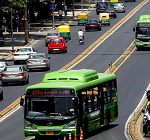City planners in India have been exploring various options to find a way out of the transportation gridlock in urban centres. Some of these alternatives have necessitated the import of practices that have worked elsewhere in the world, such as the Bus Rapid Transit System, BRTS. However, the system is unlikely to work in India unless certain ground conditions are met with.
So far, most discussions have barely touched upon what needs to be done to make it successful. Consequently, with the exception of Ahmedabad, the experiment has failed to reach its potential in some Indian cities where it has been implemented.
The BRTS was first tried out in Curitiba, Brazil in 1974 and has inspired many other cities to follow suit. Since 2013, the system has been operational in 168 cities across the world, ferrying nearly 31 million passengers every day. This includes seven Indian cities — Pune, Bhopal, New Delhi, Indore, Ahmedabad, Rajkot and Jaipur — which between them carry 308,572 passengers. [1]
Two key economic trends explain why many cities in India are keen to adopt the system. The first – as globalisation lubricates movement of peripatetic capital, urban habitats are growing beyond their existing boundaries to accommodate the influx of white-collar workforce, thereby straining the existing resources. The second trend is the changing composition of India’s GDP. With agriculture contributing only 15% of the total pie, a large section of the rural workforce is moving to the cities in search of livelihood. As city limits expand to accommodate more homes and offices the transport network has failed to keep pace.
Mumbai’s notorious traffic jams now threaten not only its productivity and efficiency standards, but also cast a shadow on its aspirations of joining an elite club of global cities. All discussions usually point to a single villain — a rise in the number of passenger cars, leading to shrinking space for public transport. While there is partly true, the reality is more complex.
More importantly, the traffic snarls are draining multiple resources — fuel, time and human energy. Therefore, many transport experts are demanding that the BRTS be introduced post-haste. Their suggestions include creating a dedicated bus lane.
However, Mumbai is so far not among the list of cities where the system will be set up on a priority basis. While Chennai, Surat, Vijaywada, Vishakhapatnam and a few others are expected to join the ranks of BRTS-enabled cities shortly, Mumbai, Vadodara, Hyderabad, Nagpur, Bengaluru, Bhubaneshwar, Chennai, Lucknow, Kanpur and Kolkata, may be considered in the future.
Meanwhile the clamour for BRTS in Mumbai grows louder. However, many things have to change before the city can even to begin to think of accommodating a globally-benchmarked BRTS-enabled infrastructure.
1. A successful BRTS needs a dedicated corridor for unhindered service. In Delhi, the corridor is used by all buses, thereby making the BRTS frustratingly slow. In Pune, a lack of coordination between institutions, faulty implementation and poor traffic management has rendered the service infructuous. [3]
2. In Mumbai heavy vehicles use the city roads at all hours while New Delhi allows heavy traffic into the city only after 9 pm. [4] This slows down transport and adds to the congestion.
3. The lack of a designated terminus for long-distance buses which park wherever there is space, stop anywhere to pick up passengers and traverse the length and breadth of the city. Long-distance buses provide a valuable service to many migrant workers living in Mumbai, but lack of proper infrastructure contributes to the choking roads.
4. The absence of proper city planning will be the biggest impediment. Expensive real estate has forced businesses to relocate to different parts of Mumbai. But, while the authorities have been liberal in granting approvals for construction of office spaces, the infrastructure has not been enhanced to meet the additional traffic.
5. The BRTS needs buses with large and multiple doors, low floors and power steering for better maneuverability. Mumbai’s first experiment with such buses resulted in frequent break-downs amid allegations of corruption.
It might be instructive to study the reasons behind the poor functioning of the BRTS in Delhi and Pune before the government pours money into such projects. It is therefore absolutely essential that a viability exercise is carried out first. Else, the programme will be pre-destined to fail. As of now, the entire BRTS project seems more like a gravy train than a futuristic bus network.
Rajrishi Singhal is Senior Geoeconomics Fellow, Gateway House.
This blog was exclusively written for Gateway House: Indian Council on Global Relations. You can read more exclusive content here.
For interview requests with the author, or for permission to republish, please contact outreach@gatewayhouse.in.
© Copyright 2014 Gateway House: Indian Council on Global Relations. All rights reserved. Any unauthorized copying or reproduction is strictly prohibited
References:
[1] BRT Data, (n.d.). Asia/India. Retrieved from website: http://www.brtdata.org/
[2] Municipal Corporation of Greater Mumbai, (n.d.). Urban transportation. Retrieved from website: http://www.mcgm.gov.in/irj/go/km/docs/documents/MCGM Department List/City Engineer/Deputy City Engineer (Planning and Design)/City Development Plan/Urban Transportation.pdf
[3] United Nation Environment Programme, (2013). Low-carbon mobility in India and the challenges of social inclusion: Bus Rapid Transit (BRT) case studies in India. Retrieved from website: http://www.unep.org/transport/lowcarbon/Pdf’s/BRT_Casestudies_India_fullreport.pdf
[4] Delhi Traffic Police, (n.d.). General questions. Retrieved from website: http://www.delhitrafficpolice.nic.in/general-questions.htm


